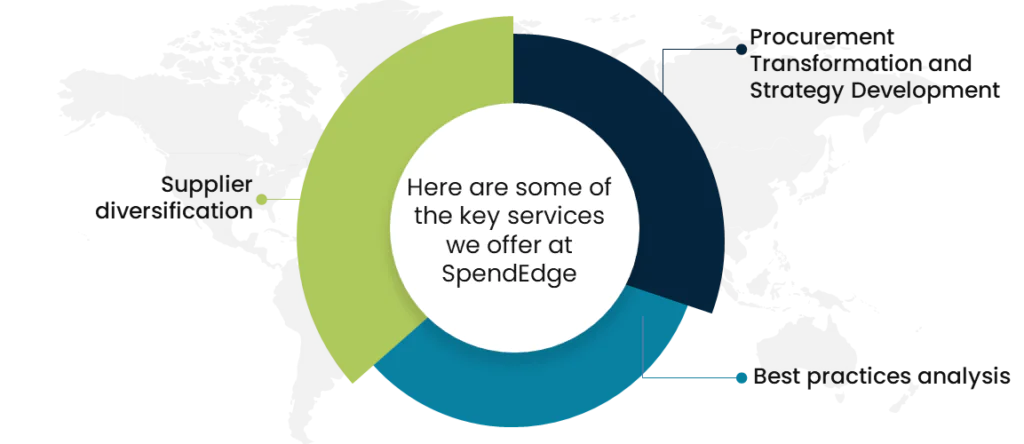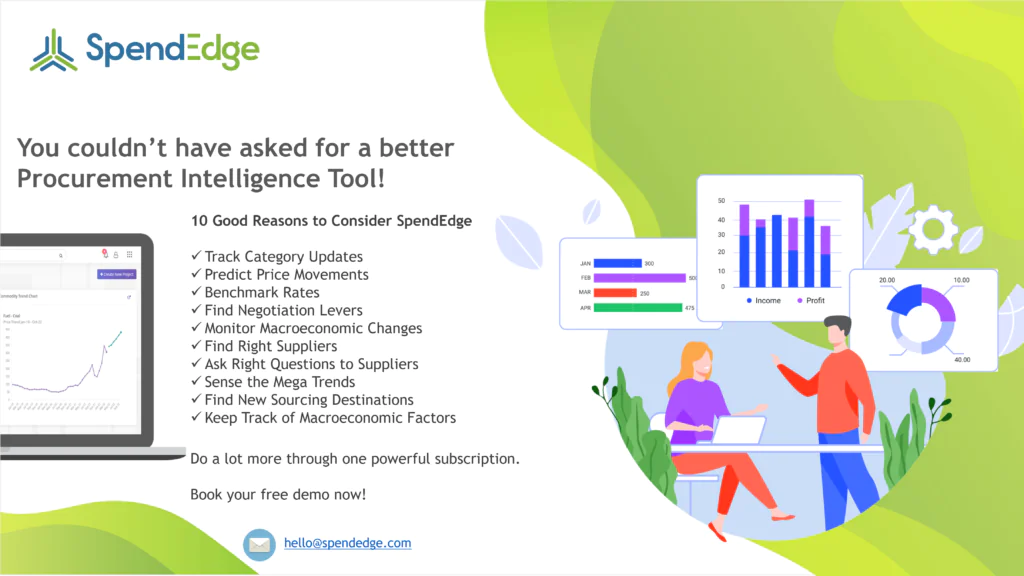By: George Mathew
Key Takeaways:
- Employing supply chain cartography, weighted risk evaluation, and VaR analysis helps organizations identify vulnerabilities and enhance resilience.
- SpendEdge offers tailored procurement solutions, including supplier diversification, procurement transformation, and best practices analysis.
- A US-based CPG company enhanced its supply chain resilience with SpendEdge’s Radar insights, optimizing operations and maintaining uninterrupted business amidst uncertainties.
- Radar simplifies supply chain risk assessment by combining country, sector, and supplier-specific data. This enables businesses to prioritize audits and improvement initiatives effectively.
Radar, is a revolutionary risk assessment tool designed to empower businesses in comprehending labour rights and environmental risks within their supply chains. Grappling with supply chain risk can be daunting, given its multifaceted nature spanning across countries, sectors, and tiers. Yet, it stands as a pivotal component in fortifying an ethical and resilient supply chain. Radar simplifies risk evaluation by amalgamating inherent country and sector risks with supplier-specific information, spotlighting potential issues. Through interactive global visualization and site-specific data, Radar unveils known risks at suppliers’ sites, along with additional issues prevalent in specific sectors, countries, or regions. This enables businesses to grasp the most probable issues in their supply chains even during the nascent stages of risk assessment, empowering them to prioritize audits, risk management, and improvement initiatives based on the most common or severe issues. By placing vulnerable workers at the core of risk assessment, Radar prompts companies to focus on how risks may affect these individuals and to formulate effective due diligence and improvement plans tailored to their needs.
Incorporating smart, cloud-based supply chain management tools like Radar aligns with the findings of the SAP 2022 Supply Chain Survey, highlighting the increasing emphasis on visibility into the supply chain and the adoption of ERP and supply chain management systems. These tools facilitate supply chain planning and visibility, fostering transparency and leveraging technologies such as blockchain to mitigate business information risks, environmental risks, and various other supply chain risks. Notably, these risks encompass supplier performance, geopolitical risk, reputational risk, climate risk, and cyber risk, among others.
In navigating the intricacies of supply chain management, the pursuit of supply chain resilience becomes paramount. Understanding the causes of supply chain risk and nurturing strong relationships across the supply chain are imperative. Moreover, recognizing the effects of supply chain disruption underscores the urgency of fortifying supply chain management practices with innovative tools like Radar. Ultimately, by embracing such technologies and methodologies, businesses can proactively safeguard their supply chains, enhance resilience, and fortify their positions in an ever-evolving marketplace.
Strategies for Assessing Supplier Risks
Supply Chain Cartography:
Initiate your risk assessment journey by crafting a comprehensive map of your supply chain network. Identify suppliers, including those at secondary tiers, and delineate their offerings and geographical locations. Collaborate cross-functionally within your organization to ensure thoroughness, especially when dealing with numerous small-scale suppliers. Utilize spreadsheets or dedicated supply chain software to create and maintain this map, updating it regularly as new partnerships form and others dissolve.
Weighted Risk Evaluation:
Employ a systematic approach that assigns weighted significance to various risk factors. Factors such as economic or political instability, financial reliance, creditworthiness, and susceptibility to natural disasters can be considered. Each supplier is then assessed and scored on a scale of 1-5 for each risk factor, with 5 indicating the highest risk level. By calculating the weighted average of these scores, you can derive a comprehensive risk score for each supplier, facilitating a comparative analysis across your partner base.
Value at Risk (VaR) Analysis:
Leverage the Value at Risk (VaR) metric, a component of the Supply Chain Operations Reference (SCOR) model developed by the Association for Supply Chain Management (ASCM). This method enables businesses to gauge the potential impact of supplier-related risks. Categorize risks encompassing political, climatic, ethical, and quality dimensions, and assign probabilities to their occurrence. For instance, quantify the financial impact of a hypothetical event, such as a hurricane affecting a critical supplier’s region. By multiplying the probability of occurrence with the estimated financial impact, you can ascertain the Value at Risk. This analysis informs strategic decisions, enabling companies to optimize sourcing strategies, mitigate risks, and enhance supply chain resilience.
Here are some of the key services we offer at SpendEdge

As SpendEdge, we specialize in delivering comprehensive procurement and supply chain solutions tailored to meet the diverse needs of businesses across various industries.
Supplier Diversification:
In today’s volatile business environment, relying on a single source for your supplies can expose your organization to significant risks. Our supplier diversification services focus on establishing alternative supply sources to reduce dependency and mitigate the impact of crises on your supply chain. We assist in identifying and vetting new suppliers, developing supply resiliency plans, and enhancing your bargaining power through better price negotiations. By diversifying your supplier base, you can enhance flexibility, resilience, and sustainability in your supply chain operations.
Procurement Transformation and Strategy Development:
Our procurement transformation services are designed to drive strategic improvements and optimize your procurement processes. We work closely with your organization to identify specific areas for enhancement and create customized roadmaps for navigating risks and achieving procurement excellence. Whether it’s streamlining sourcing processes, implementing cost-saving initiatives, or enhancing supplier relationships, we provide actionable insights and practical solutions to elevate your procurement function to the next level.
Best Practices Analysis:
Understanding the competitive landscape and benchmarking your procurement practices against industry peers is crucial for driving continuous improvement. Our best practices analysis services entail analyzing competitors’ strategies, processes, and performance metrics to identify areas of strength and opportunity. By benchmarking against industry best practices, we help you uncover process gaps, streamline operations, and implement strategies that align with your business objectives. This enables you to stay ahead of the curve and drive sustainable growth in an increasingly competitive market environment.
SpendEdge success Story: Enhancing Supply Chain Resilience for a US-Based CPG Company
Challenge:
A US-based Consumer Packaged Goods (CPG) company was grappling with supply chain disruptions, posing significant risks to its operations and profitability. Recognizing the need to enhance resilience against potential crises, the client sought the expertise of SpendEdge to navigate these challenges effectively.
Solution:
SpendEdge’s team of experts embarked on a comprehensive analysis, leveraging advanced tools and methodologies to address the client’s concerns. Using our proprietary Radar tool, we meticulously analyzed historical data, market trends, and geopolitical factors influencing the CPG industry. This enabled us to identify critical suppliers and assess the associated risks stemming from supplier concentration.
Armed with actionable insights from Radar, we devised a strategic plan for supplier diversification tailored to the client’s unique requirements. Our team conducted a thorough supplier qualification process to onboard new partners, ensuring their reliability and capability to meet the client’s demands. Additionally, contingency plans were developed based on Radar predictions to proactively mitigate the impact of potential crises.
To enhance communication and collaboration with suppliers, we established robust communication protocols, enabling real-time information exchange during disruptions. Leveraging the insights gleaned from the Radar tool, we identified specific areas for improvement within the supply chain. Customized roadmaps were then created to implement changes, encompassing process optimization, technology upgrades, and logistics enhancements.
Outcome:
With our tailored solutions, the client was able to optimize their supply chain effectively, bolstering resilience and mitigating vulnerability to unforeseen disruptions. By diversifying their supplier base and implementing proactive contingency plans, the client enhanced their ability to withstand market uncertainties and maintain uninterrupted operations. Our collaborative approach and innovative solutions enabled the client to confidently navigate challenges, positioning them for sustained growth and success in the competitive CPG landscape.

Conclusion
In conclusion, the integration of innovative tools like Radar and strategic methodologies from SpendEdge has enabled businesses to gain a clearer view of their supply chain risks and proactively address them. By leveraging smart, cloud-based supply chain management tools and incorporating strategies for assessing supplier risks, organizations can enhance visibility, mitigate vulnerabilities, and fortify their supply chain resilience. Through comprehensive services such as supplier diversification, procurement transformation, and best practices analysis, SpendEdge continues to empower businesses across various industries to navigate challenges, optimize operations, and achieve sustainable growth. The success story of enhancing supply chain resilience for a US-based CPG company exemplifies how our tailored solutions drive tangible outcomes, positioning clients for long-term success in a dynamic marketplace.
Contact us now to solve your procurement problems!
Author’s Details
George Mathew
Associate Vice President, Sourcing and Procurement Intelligence
George is a procurement specialist at Infiniti Research and provides advisory services to clients across the pharmaceutical, CPG & FMCG, energy, and automotive sectors. He specializes in the procurement areas of industry benchmarking, cost modeling, rate card benchmarking, negotiation advisory, and supplier intelligence.




